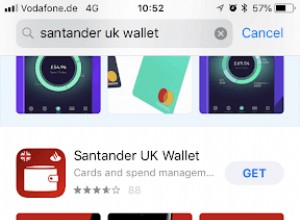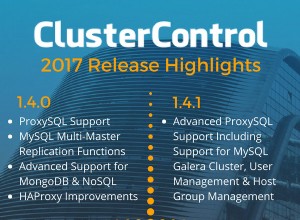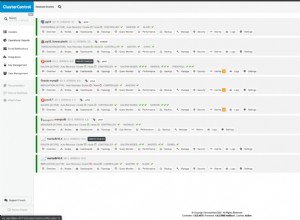Quello che in pratica ti sei perso qui è il "percorso" del campo che vuoi populate() in realtà è 'portfolio.formatType' e non solo 'portfolio' come hai digitato. A causa di quell'errore e della struttura, potresti avere alcuni malintesi generali.
Correzione del popolamento
La correzione di base richiede semplicemente il percorso corretto e non hai bisogno del model argomento poiché questo è già implicito nello schema:
User.findById(req.params.id).populate('portfolio.formatType');
Tuttavia, generalmente non è una buona idea "mescolare" sia i dati "incorporati" che i dati "riferiti" all'interno degli array, e dovresti davvero incorporare tutto o semplicemente fare riferimento a tutto. È anche un po' un "anti-modello" in generale mantenere una serie di riferimenti nel documento se la tua intenzione è fare riferimento, poiché il tuo motivo dovrebbe essere quello di non far crescere il documento oltre il limite di 16 MB BSON. E laddove quel limite non verrebbe mai raggiunto dai tuoi dati, generalmente è meglio "incorporare completamente". Questa è davvero una discussione più ampia, ma dovresti essere consapevole.
Il prossimo punto generale qui è populate() di per sé è in qualche modo "vecchio cappello", e in realtà non è la cosa "magica" che la maggior parte dei nuovi utenti percepisce che sia. Per essere chiari populate() è NON UNA ISCRIZIONE , e tutto ciò che sta facendo è eseguire un'altra query sul server per restituire gli elementi "correlati", quindi unire quel contenuto nei documenti restituiti dalla query precedente.
Alternativa $lookup
Se stai cercando "join", probabilmente volevi "incorporare" come accennato in precedenza. Questo è davvero il "modo MongoDB" per gestire le "relazioni" ma tenere insieme tutti i dati "correlati" in un unico documento. L'altro mezzo di "unione" in cui i dati sono in raccolte separate è tramite $lookup
operatore nelle versioni moderne.
Questo diventa un po' più complesso a causa del tuo modulo di array di contenuti "misti", ma generalmente può essere rappresentato come:
// Aggregation pipeline don't "autocast" from schema
const { Types: { ObjectId } } = require("mongoose");
User.aggregate([
{ "$match": { _id: ObjectId(req.params.id) } },
{ "$lookup": {
"from": FormatType.collection.name,
"localField": "portfolio.formatType",
"foreignField": "_id",
"as": "formats"
}},
{ "$project": {
"name": 1,
"portfolio": {
"$map": {
"input": "$portfolio",
"in": {
"name": "$$this.name",
"formatType": {
"$arrayElemAt": [
"$formats",
{ "$indexOfArray": [ "$formats._id", "$$this.formatType" ] }
]
}
}
}
}
}}
]);
O con la forma più espressiva di $lookup
da MongoDB 3.6:
User.aggregate([
{ "$match": { _id: ObjectId(req.params.id) } },
{ "$lookup": {
"from": FormatType.collection.name,
"let": { "portfolio": "$portfolio" },
"as": "portfolio",
"pipeline": [
{ "$match": {
"$expr": {
"$in": [ "$_id", "$$portfolio.formatType" ]
}
}},
{ "$project": {
"_id": {
"$arrayElemAt": [
"$$portfolio._id",
{ "$indexOfArray": [ "$$portfolio.formatType", "$_id" ] }
]
},
"name": {
"$arrayElemAt": [
"$$portfolio.name",
{ "$indexOfArray": [ "$$portfolio.formatType", "$_id" ] }
]
},
"formatType": "$$ROOT",
}}
]
}}
]);
I due approcci funzionano in modo leggermente diverso, ma essenzialmente funzionano entrambi con il concetto di restituire le voci "correlate" corrispondenti e quindi di "riassociare" il contenuto dell'array esistente per unirlo con il "name" proprietà "incorporate" all'interno dell'array. Questa è in realtà la complicazione principale che altrimenti è un metodo di recupero abbastanza semplice.
È più o meno lo stesso processo di populate() in realtà lo fa sul "client" ma viene eseguito sul "server". Quindi i confronti utilizzano $indexOfArray
operatore per trovare dove si trova l'ObjectId corrispondente i valori sono e quindi restituiscono una proprietà dall'array in corrispondenza dell'"indice" corrispondente tramite $arrayElemAt
operazione.
L'unica differenza è che nella versione compatibile con MongoDB 3.6, facciamo quella "sostituzione" all'interno del contenuto "estraneo" "prima" i risultati uniti vengono restituiti al genitore. Nelle versioni precedenti restituiamo l'intero array straniero corrispondente e quindi "sposiamo" i due per formare un singolare array "unito" utilizzando $map
.
Sebbene all'inizio possano sembrare "più complessi", il grande vantaggio è che costituiscono una "richiesta singola" al server con una "risposta singola" e non emettere e ricevere richieste "multiple" come populate() fa. Ciò consente di risparmiare un sacco di sovraccarico nel traffico di rete e aumenta notevolmente i tempi di risposta.
Inoltre, questi sono "real join", quindi c'è molto di più che puoi fare che non può essere ottenuto con "query multiple". Ad esempio puoi "ordinare" i risultati su "join" e restituire solo i primi risultati, dove come usando populate() ha bisogno di attirare "tutti i genitori" prima ancora di poter cercare quali "bambini" tornare nel risultato. Lo stesso vale anche per le condizioni di "filtraggio" sul "join" del bambino.
Sono disponibili ulteriori dettagli su Query dopo il popolamento in Mongoose sulle limitazioni generali e su cosa si può effettivamente fare anche in pratica per "automatizzare" la generazione di tali istruzioni "complesse" della pipeline di aggregazione, ove necessario.
Dimostrazione
Un altro problema comune con l'esecuzione di questi "join" e la comprensione dello schema di riferimento in generale è che le persone spesso sbagliano i concetti su dove e quando archiviare i riferimenti e come funziona il tutto. Pertanto i seguenti elenchi servono come dimostrazione sia dell'archiviazione che del recupero di tali dati.
In un'implementazione nativa di Promise per le versioni precedenti di NodeJS:
const { Schema } = mongoose = require('mongoose');
const uri = 'mongodb://localhost/usertest';
mongoose.Promise = global.Promise;
mongoose.set('debug',true);
const formatTypeSchema = new Schema({
name: String
});
const portfolioSchema = new Schema({
name: String,
formatType: { type: Schema.Types.ObjectId, ref: 'FormatType' }
});
const userSchema = new Schema({
name: String,
portfolio: [portfolioSchema]
});
const FormatType = mongoose.model('FormatType', formatTypeSchema);
const User = mongoose.model('User', userSchema);
const log = data => console.log(JSON.stringify(data, undefined, 2));
(function() {
mongoose.connect(uri).then(conn => {
let db = conn.connections[0].db;
return db.command({ buildInfo: 1 }).then(({ version }) => {
version = parseFloat(version.match(new RegExp(/(?:(?!-).)*/))[0]);
return Promise.all(Object.entries(conn.models).map(([k,m]) => m.remove()))
.then(() => FormatType.insertMany(
[ 'A', 'B', 'C' ].map(name => ({ name }))
)
.then(([A, B, C]) => User.insertMany(
[
{
name: 'User 1',
portfolio: [
{ name: 'Port A', formatType: A },
{ name: 'Port B', formatType: B }
]
},
{
name: 'User 2',
portfolio: [
{ name: 'Port C', formatType: C }
]
}
]
))
.then(() => User.find())
.then(users => log({ users }))
.then(() => User.findOne({ name: 'User 1' })
.populate('portfolio.formatType')
)
.then(user1 => log({ user1 }))
.then(() => User.aggregate([
{ "$match": { "name": "User 2" } },
{ "$lookup": {
"from": FormatType.collection.name,
"localField": "portfolio.formatType",
"foreignField": "_id",
"as": "formats"
}},
{ "$project": {
"name": 1,
"portfolio": {
"$map": {
"input": "$portfolio",
"in": {
"name": "$$this.name",
"formatType": {
"$arrayElemAt": [
"$formats",
{ "$indexOfArray": [ "$formats._id", "$$this.formatType" ] }
]
}
}
}
}
}}
]))
.then(user2 => log({ user2 }))
.then(() =>
( version >= 3.6 ) ?
User.aggregate([
{ "$lookup": {
"from": FormatType.collection.name,
"let": { "portfolio": "$portfolio" },
"as": "portfolio",
"pipeline": [
{ "$match": {
"$expr": {
"$in": [ "$_id", "$$portfolio.formatType" ]
}
}},
{ "$project": {
"_id": {
"$arrayElemAt": [
"$$portfolio._id",
{ "$indexOfArray": [ "$$portfolio.formatType", "$_id" ] }
]
},
"name": {
"$arrayElemAt": [
"$$portfolio.name",
{ "$indexOfArray": [ "$$portfolio.formatType", "$_id" ] }
]
},
"formatType": "$$ROOT",
}}
]
}}
]).then(users => log({ users })) : ''
);
})
.catch(e => console.error(e))
.then(() => mongoose.disconnect());
})()
E con async/await sintassi per le versioni più recenti di NodeJS, inclusa l'attuale serie LTS v.8.x:
const { Schema } = mongoose = require('mongoose');
const uri = 'mongodb://localhost/usertest';
mongoose.Promise = global.Promise;
mongoose.set('debug',true);
const formatTypeSchema = new Schema({
name: String
});
const portfolioSchema = new Schema({
name: String,
formatType: { type: Schema.Types.ObjectId, ref: 'FormatType' }
});
const userSchema = new Schema({
name: String,
portfolio: [portfolioSchema]
});
const FormatType = mongoose.model('FormatType', formatTypeSchema);
const User = mongoose.model('User', userSchema);
const log = data => console.log(JSON.stringify(data, undefined, 2));
(async function() {
try {
const conn = await mongoose.connect(uri);
let db = conn.connections[0].db;
let { version } = await db.command({ buildInfo: 1 });
version = parseFloat(version.match(new RegExp(/(?:(?!-).)*/))[0]);
log(version);
// Clean data
await Promise.all(Object.entries(conn.models).map(([k,m]) => m.remove()));
// Insert some things
let [ A, B, C ] = await FormatType.insertMany(
[ 'A', 'B', 'C' ].map(name => ({ name }))
);
await User.insertMany(
[
{
name: 'User 1',
portfolio: [
{ name: 'Port A', formatType: A },
{ name: 'Port B', formatType: B }
]
},
{
name: 'User 2',
portfolio: [
{ name: 'Port C', formatType: C }
]
}
]
);
// Show plain users
let users = await User.find();
log({ users });
// Get user with populate
let user1 = await User.findOne({ name: 'User 1' })
.populate('portfolio.formatType');
log({ user1 });
// Get user with $lookup
let user2 = await User.aggregate([
{ "$match": { "name": "User 2" } },
{ "$lookup": {
"from": FormatType.collection.name,
"localField": "portfolio.formatType",
"foreignField": "_id",
"as": "formats"
}},
{ "$project": {
"name": 1,
"portfolio": {
"$map": {
"input": "$portfolio",
"in": {
"name": "$$this.name",
"formatType": {
"$arrayElemAt": [
"$formats",
{ "$indexOfArray": [ "$formats._id", "$$this.formatType" ] }
]
}
}
}
}
}}
]);
log({ user2 });
// Expressive $lookup
if ( version >= 3.6 ) {
let users = await User.aggregate([
{ "$lookup": {
"from": FormatType.collection.name,
"let": { "portfolio": "$portfolio" },
"as": "portfolio",
"pipeline": [
{ "$match": {
"$expr": {
"$in": [ "$_id", "$$portfolio.formatType" ]
}
}},
{ "$project": {
"_id": {
"$arrayElemAt": [
"$$portfolio._id",
{ "$indexOfArray": [ "$$portfolio.formatType", "$_id" ] }
]
},
"name": {
"$arrayElemAt": [
"$$portfolio.name",
{ "$indexOfArray": [ "$$portfolio.formatType", "$_id" ] }
]
},
"formatType": "$$ROOT",
}}
]
}}
]);
log({ users })
}
mongoose.disconnect();
} catch(e) {
console.log(e)
} finally {
process.exit()
}
})()
Quest'ultimo elenco è commentato in ogni fase per spiegare le parti e puoi almeno vedere per confronto come entrambe le forme di sintassi si relazionano tra loro.
Nota che l'"espressivo" $lookup
esempio viene eseguito solo dove il server MongoDB connesso a supporta effettivamente la sintassi.
E l'"output" per coloro che non possono preoccuparsi di eseguire il codice da soli:
Mongoose: formattypes.remove({}, {})
Mongoose: users.remove({}, {})
Mongoose: formattypes.insertMany([ { _id: 5b1601d8be9bf225554783f5, name: 'A', __v: 0 }, { _id: 5b1601d8be9bf225554783f6, name: 'B', __v: 0 }, { _id: 5b1601d8be9bf225554783f7, name: 'C', __v: 0 } ], {})
Mongoose: users.insertMany([ { _id: 5b1601d8be9bf225554783f8, name: 'User 1', portfolio: [ { _id: 5b1601d8be9bf225554783fa, name: 'Port A', formatType: 5b1601d8be9bf225554783f5 }, { _id: 5b1601d8be9bf225554783f9, name: 'Port B', formatType: 5b1601d8be9bf225554783f6 } ], __v: 0 }, { _id: 5b1601d8be9bf225554783fb, name: 'User 2', portfolio: [ { _id: 5b1601d8be9bf225554783fc, name: 'Port C', formatType: 5b1601d8be9bf225554783f7 } ], __v: 0 } ], {})
Mongoose: users.find({}, { fields: {} })
{
"users": [
{
"_id": "5b1601d8be9bf225554783f8",
"name": "User 1",
"portfolio": [
{
"_id": "5b1601d8be9bf225554783fa",
"name": "Port A",
"formatType": "5b1601d8be9bf225554783f5"
},
{
"_id": "5b1601d8be9bf225554783f9",
"name": "Port B",
"formatType": "5b1601d8be9bf225554783f6"
}
],
"__v": 0
},
{
"_id": "5b1601d8be9bf225554783fb",
"name": "User 2",
"portfolio": [
{
"_id": "5b1601d8be9bf225554783fc",
"name": "Port C",
"formatType": "5b1601d8be9bf225554783f7"
}
],
"__v": 0
}
]
}
Mongoose: users.findOne({ name: 'User 1' }, { fields: {} })
Mongoose: formattypes.find({ _id: { '$in': [ ObjectId("5b1601d8be9bf225554783f5"), ObjectId("5b1601d8be9bf225554783f6") ] } }, { fields: {} })
{
"user1": {
"_id": "5b1601d8be9bf225554783f8",
"name": "User 1",
"portfolio": [
{
"_id": "5b1601d8be9bf225554783fa",
"name": "Port A",
"formatType": {
"_id": "5b1601d8be9bf225554783f5",
"name": "A",
"__v": 0
}
},
{
"_id": "5b1601d8be9bf225554783f9",
"name": "Port B",
"formatType": {
"_id": "5b1601d8be9bf225554783f6",
"name": "B",
"__v": 0
}
}
],
"__v": 0
}
}
Mongoose: users.aggregate([ { '$match': { name: 'User 2' } }, { '$lookup': { from: 'formattypes', localField: 'portfolio.formatType', foreignField: '_id', as: 'formats' } }, { '$project': { name: 1, portfolio: { '$map': { input: '$portfolio', in: { name: '$$this.name', formatType: { '$arrayElemAt': [ '$formats', { '$indexOfArray': [ '$formats._id', '$$this.formatType' ] } ] } } } } } } ], {})
{
"user2": [
{
"_id": "5b1601d8be9bf225554783fb",
"name": "User 2",
"portfolio": [
{
"name": "Port C",
"formatType": {
"_id": "5b1601d8be9bf225554783f7",
"name": "C",
"__v": 0
}
}
]
}
]
}
Mongoose: users.aggregate([ { '$lookup': { from: 'formattypes', let: { portfolio: '$portfolio' }, as: 'portfolio', pipeline: [ { '$match': { '$expr': { '$in': [ '$_id', '$$portfolio.formatType' ] } } }, { '$project': { _id: { '$arrayElemAt': [ '$$portfolio._id', { '$indexOfArray': [ '$$portfolio.formatType', '$_id' ] } ] }, name: { '$arrayElemAt': [ '$$portfolio.name', { '$indexOfArray': [ '$$portfolio.formatType', '$_id' ] } ] }, formatType: '$$ROOT' } } ] } } ], {})
{
"users": [
{
"_id": "5b1601d8be9bf225554783f8",
"name": "User 1",
"portfolio": [
{
"_id": "5b1601d8be9bf225554783fa",
"name": "Port A",
"formatType": {
"_id": "5b1601d8be9bf225554783f5",
"name": "A",
"__v": 0
}
},
{
"_id": "5b1601d8be9bf225554783f9",
"name": "Port B",
"formatType": {
"_id": "5b1601d8be9bf225554783f6",
"name": "B",
"__v": 0
}
}
],
"__v": 0
},
{
"_id": "5b1601d8be9bf225554783fb",
"name": "User 2",
"portfolio": [
{
"_id": "5b1601d8be9bf225554783fc",
"name": "Port C",
"formatType": {
"_id": "5b1601d8be9bf225554783f7",
"name": "C",
"__v": 0
}
}
],
"__v": 0
}
]
}




